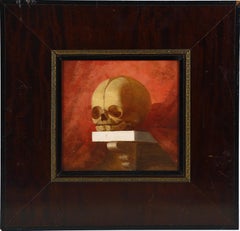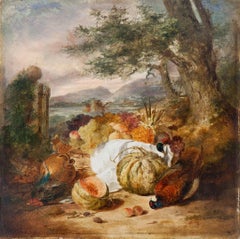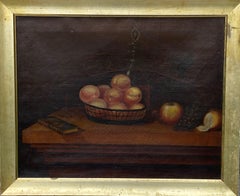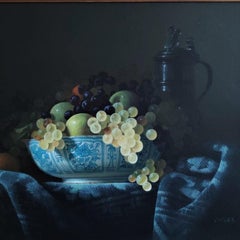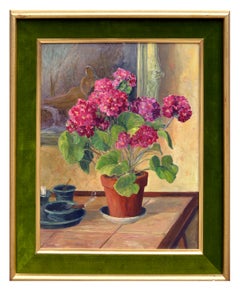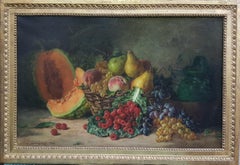1870s Still-life Paintings
to
4
5
3
7
4
2
2
2
1
3
2
Overall Height
to
Overall Width
to
1
1
2
2
1
1
1
1
1
1
1
1
1
152
318
3,774
9,100
50
50
94
182
174
243
304
271
286
309
55
1
1
1
8
8
5
5
1
Period: 1870s
Antique American School 19th Century Memento Mori Human Skull Still Life Oil
Located in Buffalo, NY
Antique American school memento mori still life oil painting. Oil on board. Framed. Image size, 7L x 7H.
Category
Realist 1870s Still-life Paintings
Materials
Canvas, Oil
"Cardinal Flowers Still Life, June" Walter Gay, Red and White Floral Bouquet
By Walter Gay
Located in New York, NY
Walter Gay (1856 - 1937)
Cardinal Flowers Still Life, June, 1875
Signed lower left; dated on the reverse
Oil on board
24 3/4 x 7 1/8 inches
Provenance:
Private Collection, Brunswick, Maine
Born in Hingham, Massachusetts, Walter Gay became a painter who specialized in interiors, particularly those of eighteenth-century French buildings. His style was traditional, and he ignored the influences of modernist paintings he saw while studying in Paris beginning 1876. He remained in Europe the rest of his life.
In his compositions, the rooms are nearly always devoid of human presence but suggest that someone has been there. Many of his interiors are museum settings, and although he was not an impressionist, his work often had atmospheric effects.
When Gay died in 1937, he was described in The New York Times as the "Dean of American Painters in France," where he and his Matilda moved in 1876. His first paintings there were genre subjects and realistic views of peasant life in Britanny, but he tired of these works, which he called "pot boilers."
In the 1890s, he began his signature interiors, mostly rooms in fashionable houses of the Gays and their friends. Reproductions of many of these paintings were published in 1920 by Albert Gallatin, also a painter. The Gays, with a retinue of about twenty servants, loved old houses, and lived in an eighteenth-century apartment on the Left Bank in Paris from January through April and beginning 1904, in a chateau in the countryside at le Breau, near Fontainebleau. There they had 300 acres of grounds to roam.
In 1907, they purchased this chateau which became quite a showplace and where they entertained extensively. However, during World War II, when Matilda was living there as a widow, German soldiers occupied the chateau, ruining much of the structure and plotting the destruction of the country the Gays loved...
Category
American Impressionist 1870s Still-life Paintings
Materials
Oil, Board
Still Life with Flowers in a Vase
Located in Milford, NH
A fine 19th century still life of flowers by French artist Louis Mettling (1847-1904). Mettling was born in Dijon, Côte- d'Or, France to English parents. He studied at the École des ...
Category
Realist 1870s Still-life Paintings
Materials
Canvas, Oil
Still Life - Oil Painting by Edward Ladell - 1870 ca.
Located in Roma, IT
Still Life is a superb original oil painting on panel, realized around 1870 by the British artist Edward Ladell (1821-1886), the best known English still-life artist.
The artwork r...
Category
Modern 1870s Still-life Paintings
Materials
Oil, Panel
American School Table Top Still Life of Fruit, circa 1875-90
Located in Hallowell, ME
Americana still life of table taop still life with fruit. Somewhat folky but lovely. Oil on canvas, 19th c frame possibly original and found in New England.
Category
Folk Art 1870s Still-life Paintings
Materials
Oil
Still life with flowers. Oil on canvas, 110x80 cm
Located in Riga, LV
Still life with flowers. Oil on canvas, 110x80 cm
Category
Realist 1870s Still-life Paintings
Materials
Canvas, Oil
“Flowers in Classical Urn”
Located in Southampton, NY
Very fine example of the artistry of the master still life painter of his day, Edward Chalmers Leavitt. Signed lower left and dated 1875. Condition is very good. Provenance: Christie’s Auction, New York, December 2, 1992, lot 228. Overall in period replica gold leaf deep cove gallery frame 25.75 by 17.75 inches.
Edward C. Leavitt (1842-1904) worked in Providence but is also associated with the Fall River School of still life painting through the influence of, and affinity of his style to, the work of Robert S. Dunning. Leavitt was a student of landscape painter James Morgan Lewin, a founder of Providence’s artistic “group of 1855.” Leavitt’s work is known for its realism, rich coloration, sharp focus and careful finish. His paintings of fruit and flowers incorporate ornate decorative pieces such as silver or bronze ewers, salvers, tankards, or plates on carved and polished tables. Leavitt was a prolific artist, exhibiting frequently at the National Academy of Design, the Boston Art Club, and the Pennsylvania Academy of Fine Arts. His work inspired other still life painters in Providence, resulting in that city’s own still life tradition, including artists such as John Clinton Spencer, Bryant Chapin...
Category
Academic 1870s Still-life Paintings
Materials
Canvas, Oil
Field flowers: exuberant floral still life in a rustic landscape country scene
Located in Norwich, GB
I have the privilege of being able to live for a little while with the paintings I offer and to "test" them. I can confirm that this particular works feels like acquiring a new windo...
Category
Academic 1870s Still-life Paintings
Materials
Oil, Canvas
Related Items
Still life with a Chinese bowl by Jean Grimal
By Jean Grimal
Located in Gent, VOV
Jean Grimal is a true 20th century discovery. This breathtaking piece is a gorgeous example of his mastery as an artist. He beautifully creates chiaroscuro in this painting. The way the light touches the edges of the Chinese bowl and the grapes is an example of his skill in representing light.
Jean Grimal (1942-1998) was born in the town of Tulle, France in 1942. Jean’s family moved to Paris when he was 8 years of age. After receiving a classical French education with studies in Latin and Greek, Jean Grimal entered the University to receive his Baccalaureate. He then attended Claude Barnard School for three years, when he received his Art Degree. Upon completion Grimal taught art for seven years. As Grimal’s own interest in formal painting and art began to possess him, the artist’s destiny changed.
In 1967 Jean Grimal stepped aside from teaching and pursued a career in professional painting and working as an illustrator in advertising. As an advertising illustrator, Grimal worked with Lise Goldfard for more than 25 years at Studio 44 where they collaborated with major and important accounts, such as: Air France, Christofle, Peugeot, Lacoste, to name a few. At the same time he began presenting his formal paintings to galleries in Paris and Cannes, France and in London and Windsor, England. Much to his surprise, Grimal found that his paintings were sought after by major art galleries and collectors throughout Europe. After a number of years of being an important and successful art illustrator for these major accounts, he found himself having to choose between the two. Fortunately for collectors, he chose to dedicate his life to the classical style of painting. Jean looked at the simplest things in life through a microscope, where he could take the simplest object and depict the age of the fruit or the leaf.
Jean Grimal received great pleasure from his work and painted for over thirty years. As his style matured and became ever more perfect Jean Grimal truly reached the pinnacle of his career. The artist’s methods were particularly distinguished when measured against his peers. Grimal’s painting skill was distinctive and exceptional.
Jean Grimal was known for his realistic trompe l’oeil and still life paintings. The artist would carefully arrange the objects to form a satisfying composition. By painting every shadow, highlight, and reflection within each composition Grimal brought mundane subjects to life. His tight rendering combined with his attention to light and detail allowed him to blur the lines between illusion and reality, truly making his works one of a kind. Grimal’s trompe l’oeil paintings consist of intricate compositions of cards, envelopes, photographs, paper of different materials and weights, backs of canvases, images of other artists’ works, kitchen utensils, pistols, and more. Grimal had a talent for mastering these illusions that deceive the eye in his trompe l’oeil paintings.
No matter what genre Grimal was painting, tight, unperceivable brushwork characterizes his work. The artist painted every crease and crinkle, every shadow and highlight, every detail. By doing so, he was able to capture each individual surface texture of the objects in his paintings. Grimal was also fabulous at depicting light in his paintings- often contrasting strong lights with strong darks, creating chiaroscuro modeling.
His still life paintings are reminiscent of Dutch seventeenth century...
Category
Realist 1870s Still-life Paintings
Materials
Canvas, Oil
Geraniums, a Cigar & Nude Figure Still Life
Located in Soquel, CA
Unique still life of a table with geraniums and a lit cigar, with a framed painting of a nude in a forest setting in the background by an unknown artist (American, 20th Century). Pre...
Category
American Impressionist 1870s Still-life Paintings
Materials
Cardboard, Canvas, Oil
Lemons in a Glass-Original realism still life oil painting-contemporary Art
Located in London, Chelsea
In Tobias Harrison's "Lemons in the Glass," the viewer is invited into a scene brimming with freshness and vitality. At the forefront of the composition sits a glass bowl, filled to ...
Category
Realist 1870s Still-life Paintings
Materials
Oil, Board
Free Shipping
H 21.66 in W 19.69 in D 3.15 in
Mid Century Red Flowers Still-Life
Located in Soquel, CA
Classic mid-century floral still-life featuring large red flowers painted with dynamic impasto brushstrokes with a background in warm orange and yellow tones by Frank McConnell (Amer...
Category
American Impressionist 1870s Still-life Paintings
Materials
Canvas, Oil, Cardboard
Mid-Century Black Eyed Susan Floral Still Life
Located in Soquel, CA
Large scale mid-century floral still-life of black-eyed susan (Rudbeckia) by listed El Paso, Texas artist Lois Coleman Denton (American, 1897-1980). Signed "Lois Denton...
Category
American Impressionist 1870s Still-life Paintings
Materials
Canvas, Oil, Cardboard
Oil on Canvas Painting -- Inness's Storm
Located in Troy, NY
This oil on canvas painting shows a fiery sky over a mountainous landscape. Bright oranges and yellows light up the sky and contrast with the deep teals and blues. There is a sense of drama and boldness in the composition of this scene. This painting is being sold with an elegant black and gold frame that complements the colors in the painting. It is signed in the back.
William Pettit...
Category
American Impressionist 1870s Still-life Paintings
Materials
Board, Oil
Small Bouquets - 16x16" oil on board
By Lu Haskew
Located in Loveland, CO
Small Bouquets by Lu Haskew
Oil 16x16" image size
Still Life of spring flowers, pansies, daffodil, in blue vases.
This painting is unframed, canvas on gator board, the price reflects that it is unframed. Online Order Only, not in gallery display.
ABOUT THE ARTIST: Lu Haskew 1921-2009
"Life is...
Category
American Impressionist 1870s Still-life Paintings
Materials
Canvas, Oil, Board
Mid Century Floral Still-Life
Located in Soquel, CA
Classic mid century floral still-life with impasto in warm, autumn colors by F. Christensen (American, 20th Century). Signed "F. Christensen"...
Category
American Impressionist 1870s Still-life Paintings
Materials
Canvas, Oil, Cardboard
LIGHT OF HEAVEN
Located in CÓRDOBA, ES
Oil painting on cardbord
Original art by Grigori Ivanov.
Founder of art style "Svetizm"
healing paintings with light and color.
Ready to hang.
Sh...
Category
Folk Art 1870s Still-life Paintings
Materials
Oil
"Shimmering Realism, " Oil painting
Located in Denver, CO
Thane Gorek's (US based) "Shimmering Realism" is an original, handmade oil painting that depicts a forest of white Aspen trees engulfed in their bright gre...
Category
American Impressionist 1870s Still-life Paintings
Materials
Oil, Board
"3 Strawberry Scoops, " Oil Painting
Located in Denver, CO
Tracy Wall's "3 Strawberry Scoops" is an original, handmade oil painting that depicts a white porcelain bowl with a silver spoon and three scoops of pink strawberry ice cream.
About the Artist:
As an artist, Tracy Wall sheds new light on everyday life, inviting the viewer to see the familiar as if for the very first time. Working with a variety of subjects, Tracy paints interesting viewpoints with compelling value, color, and shapes. Appealing compositions are everywhere, and they make strong impressions from afar even before the subject matter is recognized. She loves to balance representational impressions with more abstracted compositions.
Tracy has studied at the Art Students League of Denver under such influential artists as Michelle Torrez, Ken Velastro, Kevin Weckbach, John Lencicki, and Rob Gratiot while also participated in additional workshops from Sally Strand, Carol Marine...
Category
Realist 1870s Still-life Paintings
Materials
Oil, Canvas
Cherries in a Glass-original realism still life oil painting-contemporary Art
Located in London, Chelsea
In Tobias Harrison's "Cherries in the Glass," the viewer is transported into a world where simplicity meets sophistication. The focal point of the painting is, of course, the titular...
Category
Realist 1870s Still-life Paintings
Materials
Oil, Board
Free Shipping
H 19.69 in W 15.75 in D 1.58 in
Previously Available Items
Field flowers: exuberant floral still life in a rustic landscape country scene
Located in Norwich, GB
I have the privilege of being able to live for a little while with the paintings I offer and to "test" them. I can confirm that this particular works feels like acquiring a new windo...
Category
Academic 1870s Still-life Paintings
Materials
Oil, Canvas
H 28.35 in W 31.89 in D 1.19 in
French Naturalist VALLANCIENNE Salon Painting Still life Fruits Raspberries 19th
Located in PARIS, FR
Louis Noël VALLANCIAN Paris, 1827 – Paris, 1885 Oil on canvas 54.5 x 83 cm (65 x 94 cm with frame) Signed and dated lower left "L. Vallancienne / 1877" 19th century frame in carved w...
Category
Naturalistic 1870s Still-life Paintings
Materials
Oil
Flemish Still Life by Jean Baptiste Robie, Signed and Dated 1871
Located in Larchmont, NY
Jean Baptiste Robie (Flemish, 1821-1910)
Untitled (Still Life), 1871
Oil on wood panel
17 1/2 x 13 1/2 in.
Framed: 20 1/3 x 16 1/4 in.
Signed and d...
Category
Old Masters 1870s Still-life Paintings
Materials
Oil, Wood Panel
H 20.33 in W 16.25 in D 0.5 in
Geraniums on a Bank - British Victorian art floral still life oil painting
By Thomas Worsey
Located in London, GB
This lovely British Victorian floral oil painting is by noted flower artist Thomas Worsey. It was painted in 1872 and is of pink and white geraniums and a rose on a mossy bank. The ...
Category
Victorian 1870s Still-life Paintings
Materials
Oil
A Dainty Bit - A Woman With Lobster on a Plate and Ducks by Otto Meyer, c.1873
Located in Stockholm, SE
We found this long-lost painting by German artist Otto Meyer from a Swedish private collection.
It was featured in the 1873 magazine The Aldine and entitle...
Category
1870s Still-life Paintings
Materials
Metal
Free Shipping
H 11.42 in W 9.65 in
"Still Life with Pomegranates and Lemons, 1876" Ernest Blanc-Garin (1843-1916)
Located in SANTA FE, NM
"Still Life with Pomegranates and Lemons, 1876"
Ernest Blanc-Garin (1843-1916)
19 3/4 x 23 3/4 (29 1/2 x 33 1/2 frame) inches
Ernest Blan...
Category
Academic 1870s Still-life Paintings
Materials
Canvas, Oil
H 29.5 in W 33.5 in D 3.5 in
Benjamin Champney Still Life of Flowers in a Blue Pot American 1817-1907
By Benjamin Champney
Located in Hallowell, ME
Oil on canvas in what appears to be the original frame, unsigned but by the artist, Champney (1817-1907) began as an apprentice to a lithographer in Boston. Reportedly, the American old master...
Category
American Realist 1870s Still-life Paintings
Materials
Oil
Still Life - Oil Paint by Charles Barbaroux - 1873
Located in Roma, IT
Still life is an original modern artwork realized by Charles Barbaroux, French painter, drawer, illustrator and lithographer, in 1873.
Mixed colored oil on canvas.
Includes a gilde...
Category
Modern 1870s Still-life Paintings
Materials
Canvas, Oil
H 21.66 in W 18.12 in D 0.4 in
Still Life with Apples
By Albert King
Located in Greenville, DE
Signed lower right.
Category
Realist 1870s Still-life Paintings
Materials
Canvas, Oil
Roses Blanches - Impressionist Oil, Still Life White Flowers, Circle of E Manet
Located in Marlow, Buckinghamshire
A very beautiful oil on canvas circa 1870 from the circle of sought after French impressionist partner Edouard Manet. The piece depicts three white roses in a black vase with a single pink rose to its side. The work is exquisite.
Dimensions:
Framed: 26"x21"
Unframed: 18"x13"
Provenance:
Private French collection
Édouard Manet was from an old bourgeois family: his father was a magistrate and his mother’s father was a diplomat. He was unavoidably shaped by his origins and, however revolutionary his work may have appeared, he retained the bearing and the sentiments of a ‘society gentleman’. As a child, he already felt an irresistible attraction to painting as an occupation. An uncle who was a colonel in the artillery, and who spent every spare moment of his leisure time filling the pages of a sketchbook, passed down to him his love for drawing and took him to museums.
Having pursued his studies at Collège Rollin, Manet chose (rather than studying law) to enlist as a ship’s boy on a commercial vessel, the Guadeloupe. The long journey that he made from Le Havre to Rio de Janeiro was influential on the way in which his genius developed and later provided the inspiration for seascapes that are among the most beautiful of his era. At the time, however, he felt able only to note down fleeting impressions with some pencil strokes - a picturesque attitude here, an elusive aspect there.
On his return to France at age 18, his father acceded to his wishes, agreeing to let him follow his vocation. He arranged for him to enter the studio of Thomas Couture, where Manet remained for six years. Apart from the general rules of his art, there was not a great deal for Manet to learn from Couture, to whom success had come easily and for whom virtuosity took the place of real talent. Master and pupil did not hold each other in high regard. ‘You will never be anything but the Daumier of painting!’ Couture told him one day, a revealing comment on both painters. Manet nevertheless developed in Couture’s studio; he was given the models that he needed, after which he would go to the Louvre and set passionately to work copying the Italian and Dutch masters, Titian being a favourite.
His earliest independent works were also heavily indebted to Diego Velázquez. Journeys he made in this same period to Holland, Germany, and Italy broadened his horizons further. From 1856, he rented a studio on the Rue Lavoisier and decided to work alone. In 1859, he confronted the public. The Salon rejected his submission, Absinthe-Drinker, and a first exhibition of his work at the Galerie Martinet, on the Boulevard des Italiens, caused a scandal. The astute, elegant, and attractive bourgeois gentleman, conscious of his worth, who liked to please and felt that he was destined for a glorious career, was instantly despised by the public. The newspapers portrayed him as a madman, a vulgar Bohemian, and an anarchist. Like his friend Charles Baudelaire, he saw himself as a great Classicist who was mistaken for a rebel. Manet’s Guitar-Player (or Spanish Singer) was accepted at the Salon of 1861, however, and even won an award. The previous year, he had paved the way for these great compositions that represented the flowering of his greatest freedom of inspiration with Music in the Tuileries Gardens, in which the colours reverberate around the shadows and both the figures and the trees tremble with life.
Manet’s artistic personality is already revealed in these early works by the quality of his contrasting blacks and whites, by the intensity of his tragic effects, and by the refined delicacy of his palette, as well as by the influence of Spain, with which his art has strange affinities and which remained one of his foremost sources of inspiration. (Paris was then fêting a troop of Spanish dancers, a singer, and a guitarist). The influence of Japanese woodblock prints, which had recently become available in Paris, should not be overlooked. Japanese art suited his temperament because of its bold contrasts and the quality of its colour, clearly situated and sustained by beautiful blacks, as well as through its nonchalant forms, set off by the precision of a firm emphasis; and he was attracted to the subjects themselves - courtiers and theatrical people, artisans at their work, or women at their ablutions.
From the very beginning, Manet reacted against insipid contours and attenuated values. He employed an alla prima technique (that is, painting without underpainting), essential for the development of Impressionism. On his canvas, he placed large unified masses, ‘faces from card games’, as was said of his famous Picnic on the Grass ( Déjeuner sur l’herbe), which caused a scandal at the first Salon des Refusés that was ordered by Napoléon III alongside the official Salon of 1863. All sorts of contradictory criticisms have been made of this canvas, which was an open-air painting but also one that contained the open air of the studio, inspired as it was by Giorgione’s Concert champêtre in the Louvre. Manet worked on it for an entire year, but it has all the tonal freshness of a sketch and was described by one critic as a daub and a caricature of colour. This is to say nothing of his audacity in showing a naked woman in a wood in the company of men wearing jackets! The young woman was Victorine Meurent, a redhead with a matte complexion, a svelte figure, and an impassive demeanour who was to feature for 12 years in many of the painter’s canvases. She would distress the 1865 Salon’s established visitors once again in her next incarnation, Olympia, painted in 1863.
The gulf was widening yet further between Manet and his public. This naked girl appeared perverse, stupid, cadaverous, catlike in attitude, and indecent; the bouquet and her black servant were considered ridiculous. Finally, the face and the pallid flesh tones, through their faintly indicated contours, offended the viewers who were used to clever graduations and skilful transitions from light to shade. However, a small group of artists and writers took up a passionate defence of the work. They would meet at the Café Guerbois on the Avenue de Clichy. In this coterie, the brilliant Manet held the place of honour. Contrary to his relaxed appearances, his output of work was prodigious: he produced watercolours and etchings, studies, major topical subjects taken from contemporaneous events, portraits and seascapes. Baudelaire wrote to him: ‘They cannot recognise your talent. . . . Do you imagine you are the first person to find yourself in this position? Are you any more of a genius than Châteaubriand and Wagner? That did not stop people making fun of them. Nor did they die of it’.
People in the Salons pointed fingers at such a distinguished bourgeois gentleman who ‘painted obscenities’. Émile Zola was dismissed from the journal in which he had published his enthusiastic praise in 1867, the year of the Exposition Universelle. Anyone with any influence in society visited Paris for this event. To make his works known to the public, Manet presented them himself in a small pavilion outside the official enclosure. By this time, he had attained the most perfect degree of mastery. With strikingly restricted means, on a canvas on which he had spread a simple layer of paint, he would indicate the transition from light to shade in a few short paintbrush strokes and give resonance to his models’ luminous flesh tones, while first indicating in a unified tone some shadows that he would then emphasise violently with strokes of light. ‘M. Manet’, he wrote in the catalogue, ‘has claimed neither to overturn an old style of painting nor to create a new one. He has simply sought to be himself and none other’. It was only a few of Manet’s personal friends who bought canvases from him. Nevertheless, the paintings on show included Execution of the Emperor Maximilian, the admirable Running of the Bulls, Woman with Parrot, Guitar-Player, and Child from the Troop Playing the Fife, over which the greatest museums were to enter into disputes. When war broke out in 1870, Manet fought in defence of Paris in the uniform of the national guard. But from February 1871, he took up his brushes again.
At the Salon of 1873, a dramatic development ensued: Good Glass of Beer, colourful and solid, was not only accepted but admired both by the critics and by the public. Such a violent reversal worried the painter more than it delighted him. In fact, it turned out to have hardly any impact. The development of his art was then in full flow. Some of the young artists on whom his genius made a powerful impression influenced him in return, leading him to lighten his palette and develop a feeling for real open air.
Under the influence mainly of Edgar Degas - whom he did not much like - new and fertile sources of inspiration appeared: railways, houses on the boulevards, sofas with covers, and bathroom or kitchen utensils. From these humble objects, transfigured by their art, Manet and his friends wrought masterpieces. It was as if ‘this innovation was more unforeseen and had more consequences for artists to come than the exoticism of a Gauguin’. Thus a great new inspiration came to enliven the canvases of this period, such as the magnificent Linen of 1876, which is full of real countryside air: the fresh air that circulates throughout is not that of a studio. This stunning picture was rejected by the Salon; the mass of his contemporaries still did not understand. When Manet invited the press to see his canvas in his studio, there was a chorus of curses. ‘What forms! What colours! What flesh tints!’ cried the indignant critics. ‘The trees are the colour of flesh, the face resembles the dress, the linen has the solidity of the body and the body has the thinness and unevenness of linen’. Another critic exclaimed the following year before another open-air painting, Argenteuil: ‘M. Manet has never sunk so low. In recent years, he has exhibited some extremely clownish and ridiculous things...’. However, his friend Stéphane Mallarmé was proud to have his portrait painted by him - which was one of his masterpieces. Again in the open air, Lunch at Father Lathuile’s House radiates light and vitality, while Bar at the Folies-Bergère, for which studies were made on-site in a multitude of sketches, completely reconstructs the artificial atmosphere and every aspect of the teeming and diverse life from which the beautiful girl with the worldly expression wanly emerges under the electric lights in front of its black table and bottles.
In the same year, 1882, an exquisite portrait of a young girl, Jeanne, disarmed his fiercest opponents at the Salon. However, though still young, Manet was exhausted by all this labour; the battles had worn out his nerves, and for two years he had been experiencing the first symptoms of a terrible illness that would destroy him: progressive locomotor ataxia, as well as tertiary syphilis. He suffered increasingly frequent and painful attacks. He still produced some great compositions, luminous and stunning ones such as Monsieur Perthuiset, but more often he produced portraits, flower paintings, and still-lifes that would not require him to stand in front of his easel for long periods at a time. He worked with pastels, which he found less tiring than the brushes.
During the summer of 1882 at Reuil, he was hardly able to walk, and he used up the last of his strength on painting his garden or making some quick sketches of pretty visitors. The following winter, the illness worsened dramatically, and he developed gangrene in his left foot, which had to be amputated. Manet died on 30 April 1883. He was 51 years old, and he left 420 oil paintings, 114 watercolours, 85 pastels, and countless engravings. An engraver and lithographer, he was instrumental in reviving original etchings. From 1862, 76 etchings were made after his paintings. He also created some lithographs and posters, of which the most sought after is Cats. He produced some illustrations: in 1874, for Charles Cros’s River; in 1876, for Mallarmé’s Afternoon of a Faun ( L’Après-midi d’un faune) and Edgar Allan Poe’s The Raven ( Le Corbeau...
Category
Impressionist 1870s Still-life Paintings
Materials
Canvas, Oil
French School 19th Century, A Romantic Still-life with a sword a book and roses
Located in Paris, FR
French School of the 19th century
A Romantic Still-life with a sword, a book, a bottle and white and red roses
Oil on canvas
Signed on the lower left (barely ligible) "J Tassart"?
54,5 x 68 cm
Modern framing : 68 x 82 cm
In quite good condition : visible restorations and inpaintings (see pictures please) in the upper left around the glass and the bottle, relined.
This impressive still-life is also an allegory of epic litterature that flourishes at that time with authors like Walter Scott and his followers.
The red and white roses could make reference to the famous War of Roses...
Category
Romantic 1870s Still-life Paintings
Materials
Oil
English Flowers and Birds nest with birds eggs on a mossy bank
Located in Woodbury, CT
Vincent Clare was a Birmingham painter of fruit and flower subjects. He was the son of George Clare and brother of Oliver Clare, also both painters.
Vincent lived for most of his li...
Category
Victorian 1870s Still-life Paintings
Materials
Oil
Free Shipping
H 17 in W 15 in D 3 in
Recently Viewed
View AllMore Ways To Browse
Drive In Theatres
Oil Painitng
Valentino 2021
Impressionist Louis Valtat
Pat Doherty
St Louis Representative
18th Century Primitive Still Life Paintings
Bjarne Melgaard
Ligare David
Von Faber
Cherry Ripe
Bowl Of Cherries
D Espagnat
Red Dior T Shirt
Chinese Oil Jar
Cadogan Gallery
Heidi Von Faber
Antique Primitive Oil Painting
